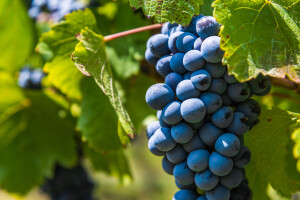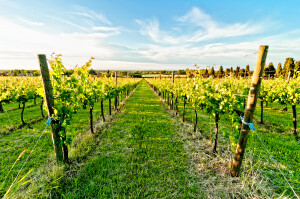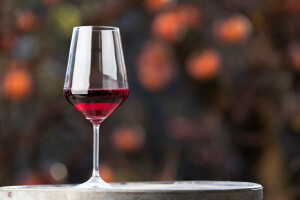Today we have a guest post from Alan Tardi, CSW. Alan gives us a deep dive in the real Lambrusco as well as a preview of his upcoming session—A Walk on the Wild Side: A New Look at Lambrusco—to be presented at the 46th Annual Conference of the Society of Wine Educators. The conference is scheduled for August 10-11 in Coachella Valley (Indian Wells, CA).
If you think Lambrusco is nothing more than a banal, reddish, cloyingly sweet bubbly, it’s time to taste again.
It happened over and over again: The first wines of a given appellation to be exported to America from post-World War II Italy were the most commercial, inexpensive, readily accessible ones possible. Some of them became quite popular, though it was often more about an appealing name or jingle or the color or shape of the bottle than it was about the wine.
In the 1960s and ‘70s, Americans started to become more familiar with and attracted to wine. At about the same time, a handful or two of visionary Italian wine producers began focusing on attaining a high-quality level of production and capturing the essence of their particular grape varieties and growing areas.
There are numerous examples of this but one of the best is Tuscany, specifically Chianti.
Prior to this time, the majority of consumers looked (often fondly) upon Chianti as a cheap, rustic wine in a straw-covered flask sitting on a checkered tablecloth next to a bowl of spaghetti and meatballs. Then it got a makeover, shed its straw, slimmed down into a Bordeaux-like cylinder and became super, sexy and more expensive. Many other wines underwent a similar transformation (think Barolo, Valpolicella, Friuli whites, Southern reds) and subsequently garnered respect and appreciation in the marketplace.
This has not happened to Lambrusco. But it should and I have no doubt that it will. Here’s why:
- Unique Terroir:
- Lambrusco is a terroir-driven wine. It grows in a very limited part of North-Central Italy, specifically a small area in the center of Emilia with a tiny adjacent zone just across the Lombardy border.
- The area where Lambrusco grows is quite unusual. While most grapevines perform best at higher altitudes up on steep slopes, Lambrusco prefers the flat plains or low hills of the Po River valley.
- Ancient Origin:
- Lambrusco is considered to be one of (if not the) oldest native Italian grape varieties, with its origin dating back to sometime around the Middle Bronze Age (c 1700 BC).
- It is thought to have originated as a wild vine that was domesticated by a mysterious group of people who inhabited the western part of the Po valley around what is now the city of Modena.
- Family of Grapes:
- In fact, Lambrusco is not a grape variety but a family of grapevines that are closely related to one another but genetically distinct.
- Thus, while they do have some basic characteristics in common, each one has its own distinct personality, and each has its own home within the larger perimeter of the defined growing area.
- Variations on a Theme: In addition to the numerus subvarieties, there are many different production options:
- Lambrusco may be made from one type of Lambrusco grape or blended with others, depending on appellation regulations.
- There are a number of specific Lambrusco appellations as well as other generic regional appellations that include a Lambrusco-based wine.
- Lambrusco runs the full gambit of sugar, from brut nature (no added sugar) to sweet.
- It can be made frizzante (lightly fizzy) or full bubbly (spumante), using the Traditional Method (in bottle with disgorgement), Ancestral Method (in bottle without disgorgement) or Martinotti Method (tank).
- Time on lees can range anywhere from days to years. And color ranges from pale pink to deep purple.
- Food Friendly:
- Emilia is considered to have one of the finest regional cuisines in Italy. The food is rich and full-flavored, and Lambrusco — whether fizzy or foamy, delicately pale and tart or dark, earthy, and tannic — provides the perfect accompaniment.
- These same basic characteristics also make it an ideal partner for many other types of food, from pizza to barbeque, burgers, spicy Asian or Indian.
- User Friendly: Lambrusco is
- versatile
- bubbly
- relatively low in alcohol
- very affordable
- fun and enjoyable; sometimes simple and rustic, other times elegant or ethereal
- undervalued and misunderstood (except by those in the know)
- Decidedly Distinctive:
- There is nothing quite like Lambrusco. It has its own unique flavor profile — earthy yet elegant, with a slightly wild streak — regardless of which guise it is wearing.
- It is red (in various hues) and bubbly (in different levels of intensity) and has tannin. It is, one could say, something of an appealing anomaly.
Alan’s session—A Walk on the Wild Side: A New Look at Lambrusco—is scheduled for Wednesday, August 10th at 8:45 am as part the 46th Annual Conference of the Society of Wine Educators, to be held August 10-11 in Coachella Valley (Indian Wells, CA). Click here to read about the extraordinary wines—as well as a few other treats that will be tasted as part of Alan’s session.
About the speaker: Alan Tardi first got interested in wine while working as a cook and chef in some of New York City’s finest restaurants and this interest blossomed into a passion when he opened his own restaurant in Manhattan in 2001. While still working long hours in his restaurant, Alan became a frequent panel taster at Wine and Spirits Magazine’s New York office and began writing for the magazine. Over time he went on to write for numerous other publications including The New York Times, Sommelier Journal, Food Arts and Wine Spectator. In 2003 Alan moved to the village of Castiglione Falletto in Piemonte, Italy where he worked extensively in the surrounding vineyards and wineries and managed the town’s Cantina Comunale. His first book “Romancing the Vine: Life, Love and Transformation in the Vineyards of Barolo” won a James Beard Award for Best Wine Book of 2006. His second book “Champagne, Uncorked: The House of Krug and Timeless Allure of the World’s Most Celebrated Drink” (2016) received a Gourmand Best in the World Award. Alan holds a CSW from the Society of Wine Educators, IWS and Champagne Master certificates from the Wine Scholar Guild and is currently pursuing the WSET level 4 Diploma.


